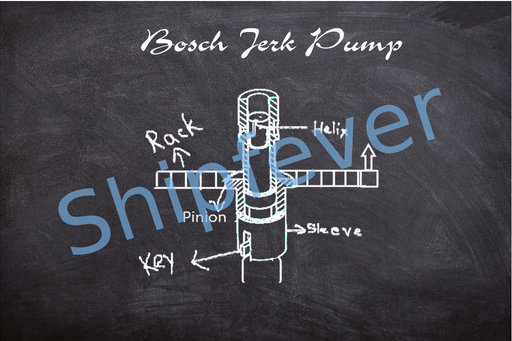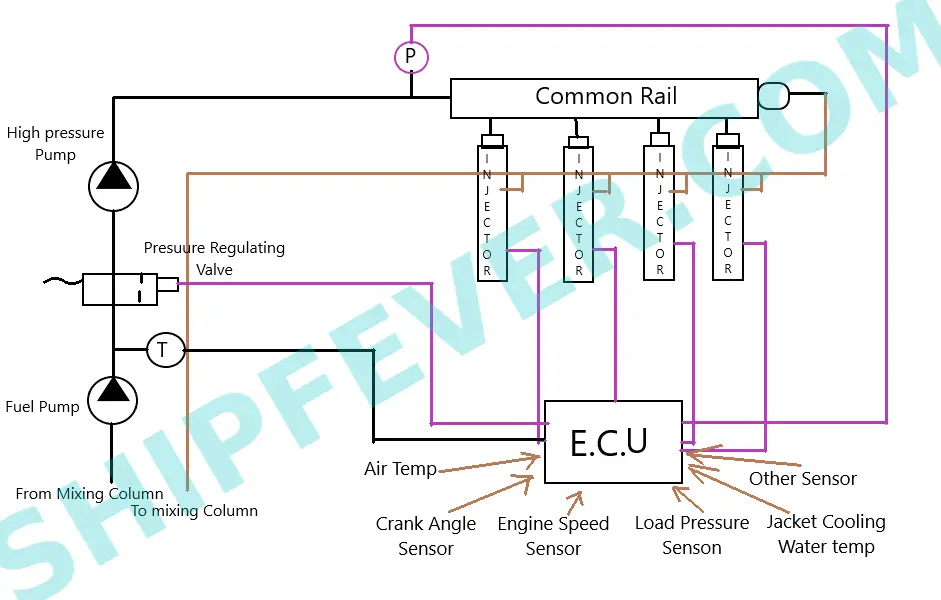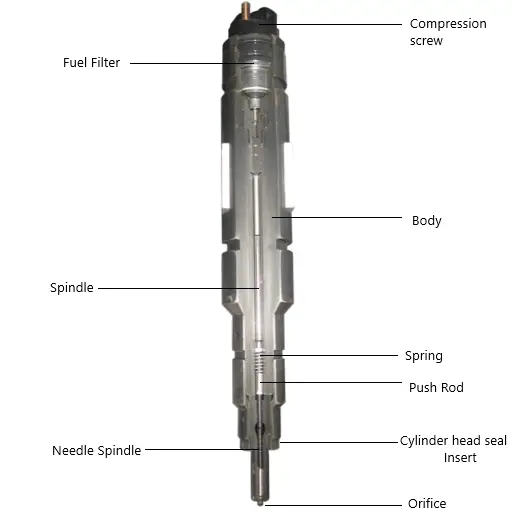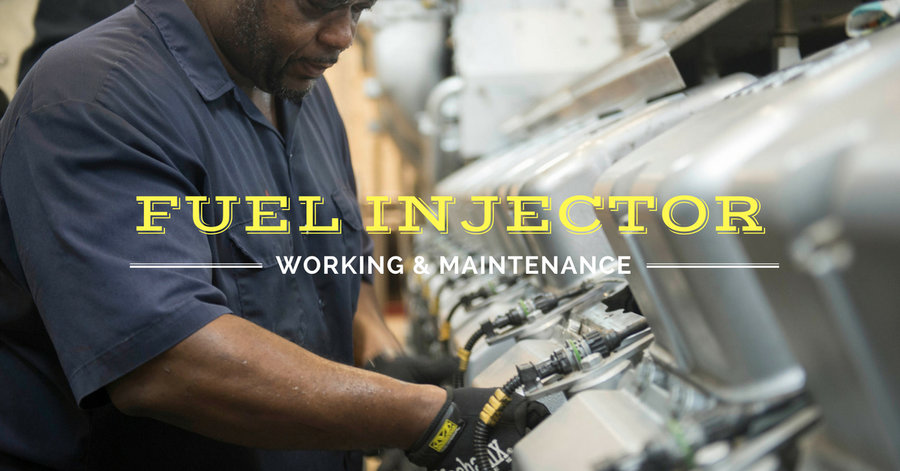Last Updated on July 4, 2018 by Amit Abhishek
Fuel pump and injector directly affects the performance of a marine diesel engine. The quality of combustion in an engine depends on the working of a fuel injector; which leading to proper automation and optimum injection timing. Atomization is the process of breaking fuel in very small particles so that it mix well with the air in correct proportion. This allows for the quick and efficient combustion of fuel particles in combustion chamber.
Proper atomization with correct injection timing is essential for high combustion efficiency. The injection pressure of fuel to be injected into cylinder is controlled by the fuel injector; and the amount and timing of such injection is controlled by the fuel pump. This injection pressure of a fuel injector depends upon its spring setting set by the manufacturer. On another hand a fuel pump works based on the position of cam and camshaft.
The timing of fuel injection is set by the manufacturer considering the camshaft speed in two and four stroke engine. To understand fuel injection system in an engine we will break the topic into two main part; fuel pump and injector.
Fuel Pump
A fuel pump works to supply a definite amount of fuel to all cylinders irrespective of the load at a correct time interval based on the firing order. The fuel pump providing a high pressure fuel to the injector; which then opens the valve against the spring tension to inject atomized fuel to the cylinder. There are mainly two types of fuel pump used in marine industry; the jerk type and common rail injection system.
1 ) Bosch Jerk Pump
A conventional marine diesel engine use a bosh jerk pump to inject fuel into combustion chamber. It contains a single piston structure called plunger which operates; based on the cam profile. A helical spring is mounted above the plunger to assist in its downward motion. The coil spring ensures continues contact between the single acting piston ( plunger ) and its followers to the cam profile.
The plunger is fitted inside a barrel with a helix machined on the top. This helix allows for controlling the amount of fuel to be injected. With the downward motion of plunger both suction and spill ports open filling the barrel with fuel oil. Now with upward movement of the plunger the pressure starts to build as soon as the ports are covered by the plunger.

At this pressure the fuel injector discharge valves are open against the spring tension to inject fuel oil. Fuel injection is then continued till the plunger starts to move down and spill ports are uncovered. The amount of fuel to be injected can be changed by rotating plunger; to change the angle of helix associated with the cylinder.
This rotational movement of single acting plunger with respect to its barrel is achieved with the help of rack and pinion arrangement. As the plunger rotates the relative position of helix with respect to the barrel starts to change; altering the amount of fuel to be injected. Additional non return valve discharge valve are fitted in some design to ensure positive seal and avoid corrosion.
To affect injection timing we need to change the effective height of the plunger in barrel. Increasing the height of plunger in barrel leads to advance injection while; decreasing its relative height / position results in retardation of fuel injection. Advanced injection on one hand cause positive change such as increase in peak pressure, thermal efficiency and overall fuel efficiency.
On another hands it also cause negative effects such as excessive vibration and shock load. While the retardation in fuel injection only leads to a series of negative effects such as corrosion, high exhaust temperature, after burning and low thermal efficiency. A proper match for advancing and retarding of fuel injector is achieved through variable injection Timing. You can learn about this “variable injection timing” in one of our old article.

2 ) Common Rail Injection System
Common rail injection system is a mode of fuel injection in which fuel is injected through a high pressure common rail. This injection method provides a optimized combustion that helps in reducing pollution and overall fuel consumption. Although the system itself is much old but have gain significance in recent times. Unlike conventional jerk pump for each unit; this injection method have a common high pressure pump for all cylinders.
Fuel oil is supplied to the high pressure pump through the fuel transfer pump via pressure regulating valve. The high pressure pump creates a pressure of around 1000 to 1500 bar; and send this high pressure fuel to the common rail. This high pressure pump can be either electrical driven, engine driven, cam operated or both. Excessive pressure in the line is leaked through a device known as pressure limiter controlled by E.C.U.
The common rail which is located at the top most part of an engine jut below the cylinder cover; maintain a common pressure through out the operation. The quality and timing for fuel injection is controlled by the solenoid valves operated by E.C.U. After analyzing received signal from crank angle sensor, scavenge air temperature, engine speed, load and jacket water temperature; E.C.U sends a signal to the injector to start injecting fuel oil to the combustion chamber.
Common rail injection system is generally used along with the exhaust gas recirculation system. Together they help not only reduce emission, control fuel consumption and lower running speed; but also help increase combustion efficiency and so does the overall plant efficiency.
Fuel Injector
After reading this article / post so far, a few people will thought if fuel pump does all the hard work; what does fuel injector do? The work of a fuel injector is to achieve fuel injection at desired set pressure. This injection pressure is set by the manufacturer and depends engine to engine. A fuel injector consists of basically two main parts a nozzle and body. The nozzle and the injector body are made in pairs and carefully grounded to produce good quality oil seal.
A fuel injector can achieve high pressure up to 500 bar by using spring loaded valve. High pressure fuel from the fuel pump then acts on the underside of the fuel injector body. This pressure when reach a certain point, it lift the needle valve against the spring tension; injecting atomized fuel oil through nozzle. Injection delivery reduce the pressure drastically from the seating area of the needle valve; causing the fuel injection to stop.
For slow speed marine engines there is a special recirculation line provided in the injector to avoid clogging / chocking of valves due to heavy fuel oil. During engine stop the booster pump is used specially to maintain oil flow in fuel injector. In some design there is also allowance for water passage in fuel injection for cooling purposes. This is provided in these engines to avoid burning and overheating of the nozzle.

Common Failures in Fuel Injectors?
- Valve Seizure: Valve seizure of a fuel injector is a condition when needle valve is either partly shut, completely opened or stuck in closed position. This leads to early ignition, leaky injector, less fuel for combustion and mixing of exhaust gas with fuel oil. This results in to localized overheating and abrasive wear.
- Over Heating: Improper cooling and faulty injector ( mechanical defects ) can leads to localized or complete over heating of fuel injectors. This can results in burning of of nozzle tip, increase smoke from exhaust along with uneven peak pressure. Actually over heating cause softening of needle valve and so results in leaky injector and then to variable peak pressure.
- Over Cooling: Over cooled fuel injector not only affects the performance of the engine but also the viscosity of fuel it delivers. Over cooling fuel injector negatively affects the viscosity of fuel causing the needle valve to stick and improper combustion in cylinder. Localized over cooling results in high corrosion at the nozzle tip affecting spray pattern.
- Slack Spring / Weak Spring Tension: A slack spring can cause the effective pressure of ignition to drop drastically. What does it mean? It means now large drops of fuel oil will fall from the nozzle tip leading to poor atomization. Even worse there will be a drop in peak pressure and after burning.
- Excessive Needle Clearance: Sometimes an increase in needle clearance can lead to abrasive wear in fuel injector. This can lead to sticking of needle valves or sluggish action. a proper clearance must always be maintained between the moving parts for such reason. Poor filtration and mixing of exhaust gas in fuel ( due to leaky injector / seizure ) is the root cause of this problem.
- Improper Penetration: Poor penetration in fuel injector can lead to localized combustion / late combustion / improper combustion / long combustion timing / after burning and high exhaust temperature. On other hand excessive penetration results into poor cylinder lubrication and high thermal stress on liner.
- Poor Atomization: Poor fuel atomization can results in a series of harmful effects; such as poor combustion, after burning, high exhaust temperature, low peak pressure and high noise level. It can be caused by poor fuel quality ( high viscosity ), faulty fuel pump ( improper injection pressure , slack spring or even obstruction in nozzle hole.
In general improper / faulty fuel injector can lead to a hard time during engine start, lack of power, loss of fuel and even misfire. That is a bad news for marine engineer as fuel pump and injector plays a great role in proper combustion and efficiency. And the main work of engineer is to maintain that engine efficiency.
Maintenance Procedure?
Maintenance of fuel injector involves the process of cleaning, pressure testing, dissembling and assembling procedure. To carry out maintenance all associated circulation line be cut off, cooling connection to be shut and removed. Proper arrangement must be taken to avoid accidental start of the engine. Fuel injector is then lifted outside the cylinder head. Nozzle tip should be inspected for signs of cold corrosion, carbon deposits and abrasive wear.
From outside the injector is then clean from a rag / cloth and fitted for pressure testing. Clean oil is used for pressure testing and is observed for any leak under constant pressure below injection pressure. Pressure is then increased slowly and checked for the correct injection pressure. Once injected spray pattern is observed and compared for any sign of deflection / abnormality. Decision for dismantling injector is taken based on the above parameters.
If the injector does not performs well during the pressure test; it is dismantled for further inspection. First we loose the spring adjusting bolt and remove the nozzle retaining nut from the injector. The dismantled parts are then cleaned by diesel oil and lapping / grinding is done if required. Once done all parts are cleaned and checked for correct clearance based on sliding test.
Sliding test is done to see whether all parts fit together or not; under appropriate clearance in between them and the body. In Ideal condition all parts must slide smoothly to fit into their place; too loose arrangement shows excessive clearance and UN-smooth slide is the indication of some problem or foreign particle. Once done all parts are assembled and again pressure tested before installing it on engine. If attempts of improving injector quality fail or the condition of injector is too bad; a new injector is replaced right away.
NOTE: This Article is produced on request from “Chirath R” on our old website.
Also Read:
- Difference Between Impulse And Reaction Turbine
- Oily Water Separator Construction Working & Dismantling
- Bunkering Operation: Precaution, Procedures & Checklist
- What’s the need to change Injection Timing? – Variable Injection Timing
- Effects Of Poor Residual Fuel On Marine Diesel Engine?


Excellent
Dear
Thanks for your efforts…
I am happy to know that the post help you get better at understanding marine fuel pump and injector.
where does the fuel which is entering to spill port goes?
The spill port of a bosh jerk pump is connected back to the pump inlet. So any ioil that spill though the port moves back to the pump inlet.
will the fuel pump injection pressure increases when speed is increased?
Injection pressure remain the same even when more or less fuel is injected into the cylinder based on governor position ( based on engine speed and load ). The governor is connected to the fuel rack which adjust the relative position of plunger and spill ports; thus advancing or retarding injection timing. This allows for fuel to be injected for long duration’s.
how much pressure fuel pump develops.at what pressure fuel is send by fuel pump into fuel injector
The bosh jerk pump generate pressure in between 0 to opening pressure of the fuel injector. The pressure is generated in the pump only when the spill ports are fully covered. Although the opening pressure of a fuel injector depends on manufacturer and engine type/model; it generally lies in between 400 to 450 bar pressure range.
what would be the injector opening pressure of man B&W fuel injector?
The injector opening pressure of a typical man B&W engine is 410 bar. But the actual injection pressure may vary based on injector condition. Please follow the manufacturer manual instruction for pressure test and re calibration for the injector to desired pressure setting.
Where we achieve the 1000 bar pressure in fuel pump.
Within the common rail.